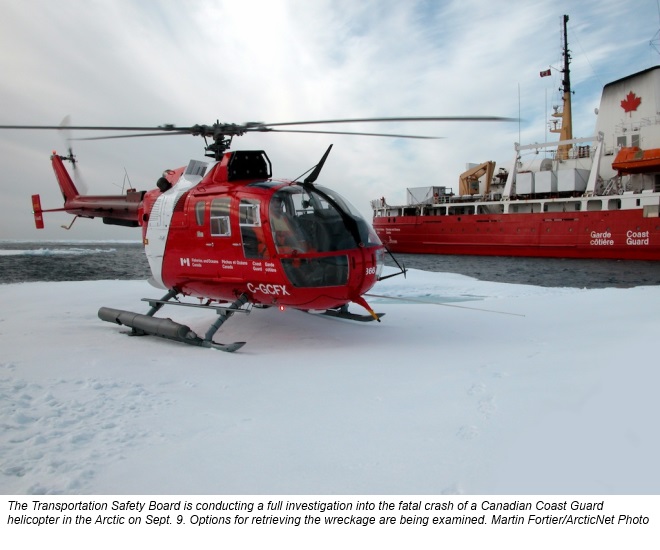Estimated reading time 5 minutes, 2 seconds.

Remotely-operated vehicles will be needed to recover the wreckage of a Canadian Coast Guard (CCG) helicopter that crashed in the high Arctic Sept. 9, sinking through the ice in more than 420 metres (1,377 feet) of water, as winter sets in.
Deployed from the CCG Icebreaker Amundsen, the Eurocopter Bo105 light twin crashed while on a routine ice survey. The bodies of the pilot, Daniel Dubé, and his two passengers, all in survival suits, were recovered from the sea by the Amundsen crew a short while later. The others were Marc Thibault, the icebreaker’s commanding officer, and Klaus Hochheim, a veteran Arctic scientist affiliated with the University of Manitoba.
The crash occurred in McClure Strait, about 600 kilometres west of Resolute, Nunavut. The first indication of a problem was the loss of signal from the aircraft’s automated flight-following system, which pings a limited amount of data back to the Amundsen.
While a CCG official said the following day that weather in the region was “clear with good visibility” at the time of the crash, John Lee, a Transportation Safety Board (TSB) official in Edmonton, said that one of the key challenges is that there were no eyewitnesses.
“And . . . the helicopter itself, which is going to have a lot of important information for us, is located at the bottom of McClure Strait,” Lee added. “So until we retrieve the wreckage, it’s going to be difficult to be able to come to any kind of determination as to cause or any underlying issues.”
Mario Pelletier, the CCG’s assistant commissioner responsible for the Central and Arctic region, told Canadian Skies on Sept. 11 that while discussions are ongoing with the TSB, the CCG has used submersibles in the past, including one to place slings and a lifting hook, to recover wreckage off the West Coast.
“I wouldn’t say it’s an easy operation but it’s not an impossible one . . . from what we know right now,” Pelletier said. “Probably by the end of this week we should have a better idea of how we’re going to approach it.” He suggested that planning could be complicated by the likelihood that it would be the Amundsen crew, who were receiving counselling at Resolute, which would be tasked with the recovery.
Restricted to VFR ops
CCG aircrews are all employees of Transport Canada, which handles recruitment and currency training. Flying in the kinds of conditions often encountered on CCG missions is complicated by the fact that the current fleet of Bo 105s and Bell 206Ls and 212s is restricted to VFR operations.
“If we go ashore to do some work and the conditions change and the helicopter cannot take off, then it stays grounded and we send a boat,” Pelletier said.
All CCG pilots have impressive log books. Dubé, for example, had just passed 10,000 hours, but Pelletier did not know how many of these hours were on the Bo 105. “All of our pilots . . . are trained on the three machines we operate.”
The CCG is proposing to replace its fleet with IFR-rated aircraft. Pelletier said that the Request for Proposals from suppliers is still in the procurement process within Public Works & Government Services Canada. “The helicopters we have are . . . coming to the end of their life,” he said. “We’re still maintaining them and they’re still in conditions that meets our requirements and the regulatory requirements.”
This is the second fatal Bo105 crash for the CCG, the first having occurred in December 2005 during a routine maintenance tour of navigation infrastructure in the rugged Burin Peninsula area of Newfoundland & Labrador. The pilot, with more than 20,000 hours logged over 25 years, and his passenger both survived the water landing, but died before they could be rescued, the pilot from hypothermia and his passenger from drowning.
No technical anomalies were found during that investigation, prompting the TSB to look at “environmental factors.” Twice before the accident, the pilot encountered snow showers and took appropriate action to remain VFR-compliant.
The TSB concluded that when he resumed the flight, the pilot may have been overwhelmed by gusting wind and low visibility and it was “likely” when he flared the slow the helicopter that “the tail contacted the water heavily, breaking off and causing the subsequent loss of control.”








